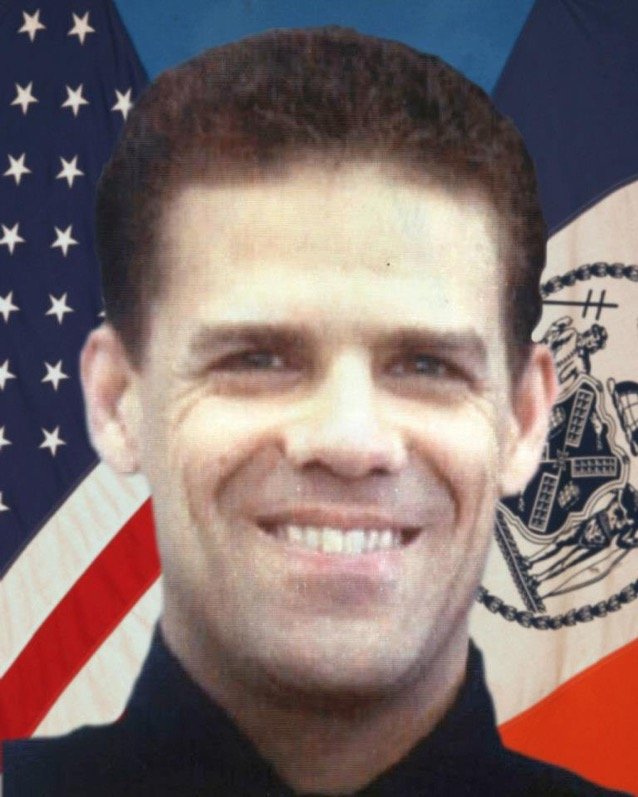Selecting two individuals from so many worthy candidates was especially difficult this month.
People make life-changing choices every day. Sometimes these choices are made out of necessity, but often people choose not to stand by and let injustices be done when they could easily remain quiet and do nothing.
This month, I selected John Perry and Sophie Scholl for the selfless decisions they made during times of crisis.
John William Perry was an NYPD officer who was filing his retirement papers at police headquarters when he heard about the first explosion on September 11, 2001. He quickly asked for his badge back and rushed to the World Trade Center to help.
Perry was a graduate of NYU Law School. Before attending the police academy, Perry had an immigration law practice. Despite growing up with a learning disability, he learned to speak Spanish, Swedish, Russian, and Portuguese.
Perry also joined the New York State Guard and worked as a social worker for troubled kids.
After retirement, he planned to work as a medical malpractice lawyer.
Seventy -two law enforcement officers and 343 FDNY firefighters were killed in the 9/11 attacks. Perry was killed while trying to help a woman in the south tower as it collapsed. Perry was the only off-duty NYPD officer killed on 9/11. He was 38 years old and had been employed with the NYPD for eight years where he was assigned to the 40th Precinct. His badge number was 3266. He is survived by his parents, brother, and sister.
An estimated 25,000 people were saved by the brave men and women who rushed to their aid. They were able to save all but 2,800 of the people working in the Twin Towers that day.
The NYPD awarded him the New York City Police Department’s Medal of Honor and President George W. Bush awarded those killed in the attack the 9/11 Heroes Medal of Valor.
Perry could have signed his papers and gone home. No one would have faulted him if he had. Instead, he chose to sacrifice his own life to help the victims of the attack.
Sources:
Image of John Parry taken from his obituary on the Officer Down Memorial Page (www.odmp.org) with no intention of copyright infringement.
Sophie Scholl (1921-1943) Sophie Scholl was a German student and anti-Nazi political activist. She was involved with the White Rose non-violent resistance group in Germany opposing Hitler and the Nazi Party Scholl was a member of the Lutheran church.
At the age of twelve Scholl became a member of the female segment of the Hitler Youth. Most of her classmates were members, so it seemed expected. After Scholl became aware of her family’s unfavorable views of Hitler and the Nazi Party, her initial enthusiasm for the group waned and she began to privately criticize the group. In 1937, Scholl’s brothers and friends were arrested for participating in the German Youth Movement, an organization formed in 1896 which focused on outdoor activities for German youth. Hitler would not tolerate any competition for the Hitler Youth.
At seventeen, Sophie and two of her siblings were arrested by the Gestapo after her brother was arrested for being involved in an anti-Hitler Youth group.
After graduating high school, Sophie wanted to go to the university, but she didn’t want to become part of the Nazi controlled National Labor Service which was a prerequisite for being accepted at university. She taught kindergarten hoping it would be accepted as an alternative service. When it was not, Scholl began a six-month stint in the NLS as a nursery teacher. After experiencing the military-like structure of the NLS, Sophie began to practice passive resistance.
Scholl enrolled at the University of Munich where her brother Hans was a student. She joined his social circle and found like-minded friends who shared a love of music, art, outdoor activities, and eventually politics and philosophy.
In 1942, Scholl had to spend the summer doing “war service” in a factory while her father was serving a prison sentence for making a remark critical of Adolf Hitler.
In 1942, the White Rose was formed. Hans Scholl and Alexander Schmorell wrote the first four leaflets. Containing passages from the Bible and quotes from German authors and poets, the members of the White Rose hoped the leaflets would appeal to German intellectuals and inspire them to speak out about the dangers of fascism.
In February 1943, Sophie and Hans went to Ludwig Maximilian University to leave pamphlets out for students to read. While Sophie was attempting to toss the last of the pamphlets off the top floor into the atrium, a janitor, Jakob Schmid, a self-proclaimed Nazi, saw her and immediately alerted the authorities. Sophie managed to hide any remaining pamphlets in an empty classroom, but Hans had one left. He was attempting to tear it up and swallow it when he was captured. Sophie and Hans were taken into custody by the Gestapo. Who pieced together enough of the pamphlet to match it to the other pamphlets left at the school.
Under pressure, Hans gave up the name of the author of the pamphlet, Christoph Probst. Sophie’s interrogator initially believed she was an innocent bystander, but after Hans’ confession, she confessed and attempted to take full responsibility to save the lives of other White Rose members.
In a sham trial Hans, Sophie, and Christoph were convicted of treason and sentenced to death for distributing non-violent pamphlets. They were beheaded by guillotine. Sophie was executed first, followed by her brother Hans, then Christoph.
After her death, a copy of the sixth pamphlet was smuggled out of Germany. Copies were made of it and in mid-1943, the Royal Air Force dropped millions of propaganda copies of the tract over Germany.
Books, documentaries, songs, plays, and films have been made about Sophie Scholl and her bravery. Schools are named for her.
Sources:
Wikipedia
Photo of Sophie Scholl:
By Jürgen Wittenstein [fr] (1919-2015) (source). - Original publication: 1942Immediate source: https://www.nationalww2museum.org/war/articles/sophie-scholl-and-white-rose, Fair use, https://en.wikipedia.org/w/index.php?curid=69686995








